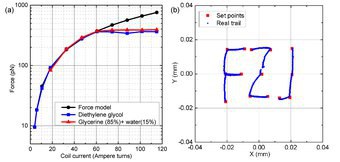Magnetic Tweezers and Magnetic Twisting Cytometry
High throughput microrheometry for cell mechanics studies

As a powerful and versatile scientific tool, magnetic tweezers (MT) have been widely used in biophysical research areas, such as mechanical cell properties characterization and single molecule manipulation. In our lab, we set up multi-pole electromagnetic tweezers to manipulate magnetic particles in 2D/3D. This apparatus consists of a hexapole electromagnetic yoke with 3 or 6 magnetic tips, power amplifier, microscope, digital camera, and a computer with RIO card.
In general, the force experienced by the magnetic particle can be derived from the induced magnetic moment and the gradient of the magnetic field. With sharp magnetic tips, high field gradients can be generated in the workspace. By varying the coil currents, the force on a particle can be controlled.

The position of magnetic beads are measured by video microscopy and a particle tracking algorithm (down to few nm). For example, with an effective workspace of 0.1×0.1 mm2 enclosed by 3 magnetic tips, a force of 400 pN can be applied on a Dynabead M270. Higher force is available by adopting a smaller workspace. With the help of an inverse force model, active feedback control is achieved with a digital P/PI controller.

Based on the previous MT setup, a 2D optical magnetic twisting cytometry (MTC) has been implemented. In MTC, the rotation of polarized magnetic beads upon a small twisting magnetic field which is generated by the hexapole electromagnet, can lead to planar movement. Unlike MT, no sharp magnetic tips are needed in MTC. In order to obtain high remanence of the ferromagnetic beads, a separate electromagnet with feedback control was adopted for the high magnetic field polarization. With a heterodyning technology, the measurement frequency can be extended to the 1 kHz range. Our setup constitutes the first instrument which can be operated both in MTC mode and in MT mode.
Publications
La Chen, Andreas Offenhäusser, and Hans-Joachim Krause, Magnetic tweezers with high permeability electromagnets for fast actuation of magnetic beads, Rev. Sci. Instr. 86, 044701 (2015).
La Chen, Vanessa Maybeck, Andreas Offenhäusser, Hans-Joachim Krause, Implementation and application of a novel 2D magnetic twisting cytometry based on multi-pole electromagnet, Rev. Sci. Instr. 87, 064301 (2016).
Contact:
Prof. Dr. Hans-Joachim Krause
Tel.: +49-2461-61-2955
e-mail: h.-j.krause@fz-juelich.de
